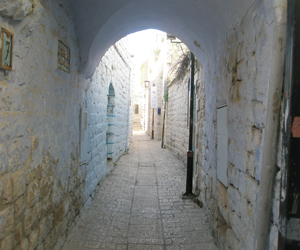Beit Hameiri
Beit Hameiri (Hameiri House) is a historical museum documenting the life of the Jewish community of Safed over the past 200 years. Its founder, Yehezkel Hameiri (1934 - 1989), a fifth generation native of this town, spent thirty years restoring the ruined building he knew from his childhood. The museum tells the story of Safed and sheds light on an important chapter in the history of Eretz Israel.
On each of the museum's floors and levels, a different aspect of the community's daily life is presented to the visitor. According to the elders of Safed, the rooms at street level are more than 400 years old. Next to the living quarters is a small 16th century mikveh (ritual bath) which used rainwater collected in winter. Its vaulted ceiling was covered by earth over the years and a giant fig tree struck roots in its walls. The mikveh is not open to the public.
Across the courtyard is a synagogue that served the Persian community, originally built by the Hameiri family. It was damaged and abandoned many years ago, but is now partially restored, commemorating its founders.
Above the ground level, which has survived almost in its entirety, is a garden that was planted on the ruins of rooms which collapsed in the earthquakes of 1759 and 1837.
At the heart of the main museum building are two large vaulted halls. These are 150 years old and served as part of Safed's rabbinical court until the turn of the century. During the First World War, hundreds of orphaned children were housed here. Safed experienced terrible hardships in that troubled period - two thirds of its population were decimated in a typhus epidemic. Today in these halls you will find a display of paintings telling the story of recent generations of Safed's colorful elders. There're images, documents and utensils illustrating the hardy nature of this unique community.
Access to the next floor of the museum is through a passageway with more images of Safed's old-timers, and then via the low vaulted rooms which served as the cellars of the house on the top floor. These contain a collection of utensils, implements and craftsmen's tools. The final flight of stairs, discovered during the restoration work, leads to what used to be a schoolyard. More than 100 years ago, Jewish children studied here, in what was Safed's first Hebrew school, set up in the days of Baron Rothschild. The terrace opens to a view of Mt. Meron. Below the museum building you can see the flat roof of the Sephardi Ari synagogue, the ancient cemetery with its blue tombs, and the Ari mikveh. To the south is the old Arab quarter, from which murderous mobs came storming into the Jewish quarter in the 1929 and 1936 uprisings.
The school closed down during WW 1, due to the hunger and disease. Its classrooms later served as living quarters for various local families, and in 1936 the balcony became a strategic outpost overlooking the Arab quarter. This outpost was used again by the defenders of Safed in the 1948 War of Independence. The rooms on this floor contain displays of different aspects of daily life in Safed traditions, struggles and faith.
The Reconstructed Room shows a typical Safed home of the Turn of the Century. What strikes the viewer is the simplicity and meager means of its inhabitants. What also comes across is their joy of life and close-knit family structure.
In the Religious Life of Safed, the visitor will find a collection of ritual objects used by many generations of Safed's Jews. Their deeply rooted devoutness finds expression here in the inscribed stones, illuminated manuscripts, candlesticks and many other items on display.0
Heroic Safed is an exhibition of documents and items from the long and sometimes seemingly hopeless struggle for survival of the Jewish Quarter, up to the liberation of Safed in May 1948. The room itself served as a forward position in the War of Independence - its windows were sealed and firing slots were cut into the walls in the defenders' stand against the Arab onslaught.
The room in memory of the museum's founder documents his many achievements. All the newspaper articles, books and research papers he wrote are kept here.
Opening hours: Sunday - Thursday 8:30 - 14:30, Friday and holiday eves 8:30 - 13:30.
Beit Hameiri, 158 Keren Hayesod Street, Tsfat, 1320212.
Tel. 04-6971307, 04-6921939. Fax. 04-6921902
From a museum guide brochure

